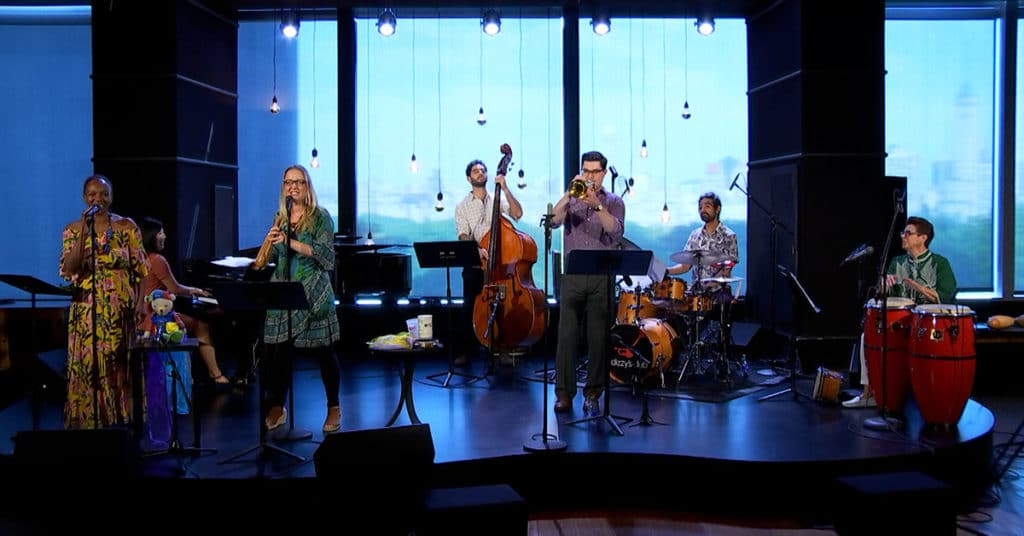The Webop Virtual Family Jazz Party is streaming on demand at jazz.org/wfjp from June 26 – July 18, 2021. $10. (It’s actually pay what you can. Jazz at Lincoln Center deserves our support, but if you can’t afford it, enter $0. Being together is more important than money.)
Webop Virtual Family Jazz Party

This 45-minute interactive jazz concert is recommended for families with children 8-months to 8-years old, but Jazz at Lincoln Center makes all ages swing. It’s led by Ms. Goussy and Ms. Sofía.
The band is:
- Vocals Goussy Célestin and Sofía Tosello
- Trumpet: Tatum Greenblatt
- Piano: Mika Nishimura
- Bass: Pablo Menares
- Drums: Juan Carlos Polo
- Percussion: Mayra Casales
In a way, this is just a family jazz party for kids, but there is actually a lot of context here.
Ms. Goussy Célestin
Goussy Célestin is a New York jazz musician and dancer who explores New Orleans and Haitian music and dance traditions. That’s really important because the Haitian diaspora had a profound influence on what became Latin music in the Caribbean and New York City, what became blues in the United States, and what became jazz in New Orleans. From the gospel and the blues to Latin trap, all popular music and dance of the United States grew from these roots. goussycelestin.com
Jazz is Creole, but Creole is code for Haitian and Haitian diaspora. Modern jazz Bebop and Latin jazz Cubop were born together in New York City in the 1940s. The bop in Bebop, Cubop and Webop is syncopation in all its possibilities. That is a signature of Haitian and West African culture. It’s the tumbao (the natural swing in a woman’s walk). It’s the swing in swing.
Ms. Sofía Tosello
Sofía Tosello is a New York Argentine jazz singer who works in tango and Argentine folklore, Afro-Peruvian and Caribbean rhythms. All of these derive from African and Indigenous roots with European influences. Like most Argentines, Tosello is Italian descent. Argentines are very proud of being “Criollo” or Americans of the Americas and Argentine folk music is mostly Indigenous. sofiatosello.com
Creole and Criollo
Between Creole and Criollo, Ms. Goussy and Ms. Sofía represent almost the entire Latin world. Que chévere.
“Chévere” is a French word that means “cool” in Puerto Rico. That’s also a remnant of the Haitian Diaspora. There are Haitian footprints all over the Caribbean and New Orleans. Even Trinidad Carnival, the mother of Caribbean Carnival was created in Trinidad by the Haitian Diaspora.
El Barrio
“El Barrio” East Harlem is NYC’s iconic Latin community. The once Jewish community became Italian and then famously Puerto Rican. Today it’s becoming Mexican.
El Barrio is on the east side of Fifth Avenue at the top of Central Park. West of Fifth Avenue is Harlem, NYC’s iconic African American community.
Fifth Avenue at 110th St is where Duke Ellington Circle meets Tito Puente Way. That’s some urban poetry.
Back in the day Latin musicians (including a young Tito Puente) used to cross Fifth Avenue to listen to the jazz cats in Harlem. Jazz musicians used to cross Fifth Avenue to listen to Latin musicians in El Barrio. We mixed together in Harlem and East Harlem ballrooms, at the jazz clubs on 52nd St, the Palladium Ballroom, and downtown at the Village Gate.
Dizzy Gillespie, one of the father’s of bebop, was in the middle of it all. While Dizzy, Charlie Parker and others were creating bebop at Minton’s in Harlem (the room is still a jazz club), Machito and his music director Mario Bauzá were creating cubop (cubop is Cuban bepop or Latin jazz) at the Palladium Ballroom. Dizzy asked Bauzá for a conga player and got Chano Pozo. That gave us jazz standards like “Manteca” and “Tin Tin Deo.” It also brought Latin percussion back into mainstream jazz.
Today nobody thinks twice about hearing Latin percussion in straight ahead jazz, but it wasn’t always so. We have to thank Dizzy Gillespie for that. Jazz and Latin jazz are a natural fit because they were separated at birth in the Caribbean. In the Colonial Era, they took away the drum and we got the blues. Dizzy brought it back.
Singing and Dancing with Your Kids
Most culture begins at home. We walk and talk and sing and dance the way our parents did. Our heritage traditions are designed to bring people together. That’s why they are so powerful and so fun. Kids have a natural bop, and the Webop Virtual Family Jazz Party is a great place to be a kid or be with your kids.
